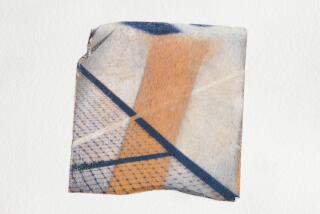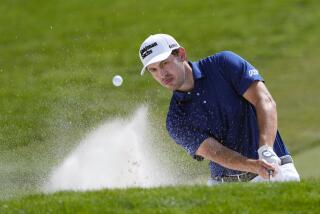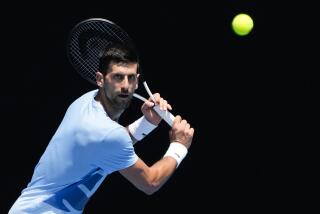Other Side Is Mr. Hide
PALO ALTO — “Come o-n-n-n!” he squeals, sounding like a wounded wombat, pumping his fists and cursing at the imaginary adversaries he has invented on his way to the top of his sport. And his sport just sits there, wondering what to make of this impudent kid in the backward baseball cap who has turned men’s tennis on its head.
“Come o-n-n-n!” Lleyton Hewitt shouts, and the rest of tennis does a double take, giving serious thought to a question that has yet to be sufficiently answered: If Hewitt’s doing the leading, are we really sure we want to go with him?
There are champions of the moment--Marat Safin, Thomas Johansson, Albert Costa--instant lottery winners who take their prizes, do their news conferences and fade quickly into the background. Staying power is a rarity. Men’s Grand Slam champions of late seem to come equipped with ticking clocks.
Hewitt has changed this time-share arrangement at the top, apparently having settled in for the long haul. Top-seeded this year, he won the U.S. Open last year, becoming the youngest No. 1 in ATP history at 20, then added a Grand Slam bookend with his Wimbledon title in July at 21.
He wins and he snarls. He loses, less frequently, but the snarl remains. Consistency is both Hewitt’s strength and his weakness. His world is a simple one, divided neatly into casts of supporters and enemies. Chair umpires, linespeople, reporters, opponents, tour officials, who you are doesn’t matter--if you’re not with him, the way Hewitt looks at it, you are most assuredly against him.
“I’m competitive. I’m the first to admit that,” he says. “That’s me. It doesn’t matter if I’m swimming against [Olympic champion] Ian Thorpe, I’ll try and win. I know I can’t, but I’ll try and do my best.
“That’s probably one reason why I’ve probably been able to do as well as I have, because I go out on the court and try and give everything I’ve got every time.”
That much the rest of tennis learned long ago. But what else do we know about Hewitt, the economy-sized firebrand from Adelaide, Australia, with the formidable groundstrokes and the attitude to match?
Rather than providing clues, Hewitt’s triumph at Wimbledon only heightened the mystery. Australian writers, deprived of easy access during the tournament, were holding secret meetings with his family to help improve the situation. Reporters from other countries joined the pursuit. One was spirited into the house of Hewitt’s entourage at Wimbledon to speak with his parents, Glynn and Cherilyn, in the basement, but was asked to stay in hiding because Lleyton had unexpectedly arrived with his girlfriend, tennis pro Kim Clijsters.
The Wimbledon title--taken with the loss of only two sets in seven matches--accelerated the unveiling of Hewitt. Then, after he’d pulled out of an event in Los Angeles because he was sick, his people were willing to make him available at the Stanford women’s tournament where Clijsters was playing.
There the Hewitt we’ve come to see on the court was missing.
Where was the tennis brat columnist John Feinstein had recently compared to Barry Bonds, calling them champions who were “absolute chumps as human beings?”
Where was that rumored chip the size of New Zealand on his shoulder?
The heir apparent to John McEnroe, Jimmy Connors and early Andre Agassi was polite, reflective and even modest about his abilities.
This had an almost “Wizard of Oz” feel. On a bench near the practice courts at Stanford, Hewitt--the screaming, polarizing No. 1 who’d once called an umpire “a spastic” and had slid into a racially tinged controversy while playing African American James Blake at the 2001 U.S. Open--seemed more like a shy, skinny kid looking for the area’s best skateboarding park.
“I think you learn from your mistakes now and then,” Hewitt said. “Then again, sometimes people try to find the negative thing out of anything to write about. That’s the disappointing thing.”
So little was known about Hewitt, and outside of a couple of acquaintances in the media in Australia, he had little reservoir of goodwill when various controversies hit in the last year or so, including the break in December with respected coach Darren Cahill. He has been revealed in fits and starts, meaning that his story remains hard to tell.
“I’m probably more shy off the court than people probably think,” he said. “I’m not the biggest fan of going there and standing up and telling stories about myself.”
To that end, he has spoken a couple of times to the most outgoing and affable of previous Australian champions, John Newcombe, who was also Hewitt’s first Davis Cup captain.
“Talking about yourself, I find that a little bit tough,” Hewitt said. “I spoke to Newk a couple of times about it because he talks so well. He has so many stories to tell over the last 50 years he’s played this game. He said when I’m his age, I’ll have stories to tell as well. It’s tough for a 21-year-old to go out there and stand up in front of a lot of people. That comes with experience.”
The dual Hewitts are not a new development. His agent, Tom Ross, learned this from Hewitt’s mother when he was recruiting the youngster.
“She would often say there’s two Lleytons,” Ross said. “There was the Lleyton on court, who is this fiery personality and an incredible competitor.
“Off court, you wouldn’t recognize him. He’s this shy little kid who sits in the back of the class.”
One consistent thread was his passion for winning--at everything.
Hewitt says he got his body type and endurance from his mother, who was a netball player, and his quickness from his father, a former Australian rules football player. Competitiveness came from both sides.
Oftentimes, junior players go through periods of petulance--tanking a match or throwing a set or simply retiring. Hewitt looked stumped when asked if that ever happened in his childhood.
“I always gave 100%. I can’t remember once, I honestly can’t,” he said.
This, combined with his counterpunching abilities, makes him a fitting successor to Connors, who, like Hewitt, won his first Wimbledon at 21.
Beyond that, he shares Connors’ fighting spirit on the court and the ability to raise his level in hostile circumstances.
“He’s pretty strong-headed,” said Patrick McEnroe, ESPN commentator and U.S. Davis Cup captain. “That’s why he’s No. 1 in the world. He’s always reminded me of Connors. When he first came on the tour, the way he played, a me-against-the-world type of mentality.
“Which, quite honestly, isn’t the worst thing to have for a tennis player. He thrives on that. Jimmy was like that in a lot of respects, ‘I’m going to screw everybody, and show everybody.’ In tennis, you can get away with that.”
Said Hewitt: “There’s a few times when people tried to hop on the train, and try bagging you. It doesn’t worry me. It doesn’t affect my tennis. I don’t think people really realized that until probably the U.S Open last year.
“It’s happened so many times in Davis Cup. I was getting bagged before I played in Spain. I went out there and beat [Albert] Costa in five sets in Barcelona. The crowd doesn’t worry me when I go out there. I’m able, for some reason, to block it out and play my best tennis.”
The similarities to Connors don’t end there. When Connors won at Wimbledon in 1974, he was dating Chris Evert. Their engagement was viewed by many as the class rebel hooking up with the leader of the pep squad. Hewitt has been seeing Clijsters since he met her at the Australian Open in 2000, attending as many of her matches as possible. Clijsters is well liked by media and her peers on the tour.
“Watching Kim affects me,” Hewitt said. “I want her to win every time she steps on the court. It’s tough. When you’re out there, you don’t feel those same sorts of pressures. You’re sitting off the court and you’re thinking, ‘Get a first serve in here,’ and then they miss it. I couldn’t do it week in and week out.”
Like Hewitt, Connors had his media problems and conflicts with tour officials in his day, even filing a $40-million antitrust lawsuit against the ATP officials and others, charging a conspiracy to monopolize pro tennis.
Hewitt’s difficulties with the ATP aren’t quite of that nature, but even on the eve of his U.S. Open title defense he was prepared to spar with that organization. He was fined $105,650 by the ATP for refusing to conduct an interview with ESPN this month before his first-round match at Cincinnati.
There is an appeal pending, but Hewitt hired counsel in Indianapolis this week, Barnes & Thornburg, to handle the matter should legal action be required. His camp felt an arrangement with the parties had been reached before the matter exploded at the tournament.
“Based upon Lleyton’s experience with the tour to date, it’s not hard to understand he felt the need to engage a litigator,” Ross said. “There was some extremely bad judgment used by certain tour staff--and Lleyton paid the price.”
One of the members of the appeals panel used to be Patrick McEnroe. He has stepped down from the position, citing his Davis Cup position as well as his broadcast responsibilities. McEnroe speaks highly of Hewitt as a performer and personality, but says that being No. 1 carries extra responsibilities.
“The tour has got to have some power here,” he said. “The Lleyton Hewitts of the world have a lot more being asked of them. You need to do more when you’re at the top of the sport.”
For Hewitt, the good still outweighed the bad a few weeks ago at Stanford. This was before the ATP feud, long before he’d told an Australian newspaper that the men’s tour was a badly run “circus.”
On this day, there was still a Wimbledon afterglow and the thrill of holding the No. 1 ranking, talking about his favorite band, Midnight Oil, and getting to play on Tiger Woods’ collegiate golf course.
So, what would the top tennis player want to ask the top golfer?
“The way that he handles himself every tournament he goes into, everyone expects him to shoot 65 every day,” Hewitt said. “That’s an extraordinary thing. The way he’s been able to block everything out and concentrate on going out there and doing what he does best. If there is a secret for him doing that, I’d like to know it, to try and keep my ranking and majors going as long as I could.”
*
(BEGIN TEXT OF INFOBOX)
*--* Quick Study Lleyton Hewitt at a glance: Country: Australia Age: 21 Recent U.S. Opens: 2001-won, 2000-semis, 1999-3rd, 1998-DNP Notable: At 5 feet 11, 150 pounds, he doesn’t overpower many players but chases down just about everything an opponent hits. ... Few players return serve better. ... At 20, finished 2001 as youngest year-end men’s No. 1 2002 REVIEW Singles record 45-10 Singles titles 4 Doubles record 4-6 Doubles titles 0 Prize money $1,863,989 CAREER Singles record 240-77 Singles titles 16 Double titles 2 Prize money $8,107,404 Times Wire Services
*--*
More to Read
Go beyond the scoreboard
Get the latest on L.A.'s teams in the daily Sports Report newsletter.
You may occasionally receive promotional content from the Los Angeles Times.







